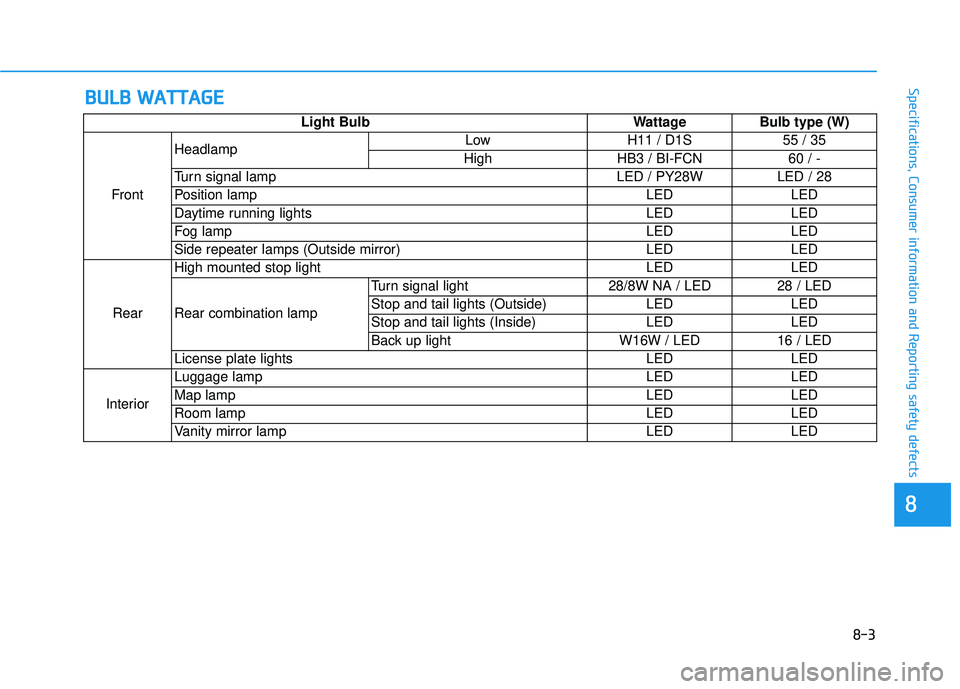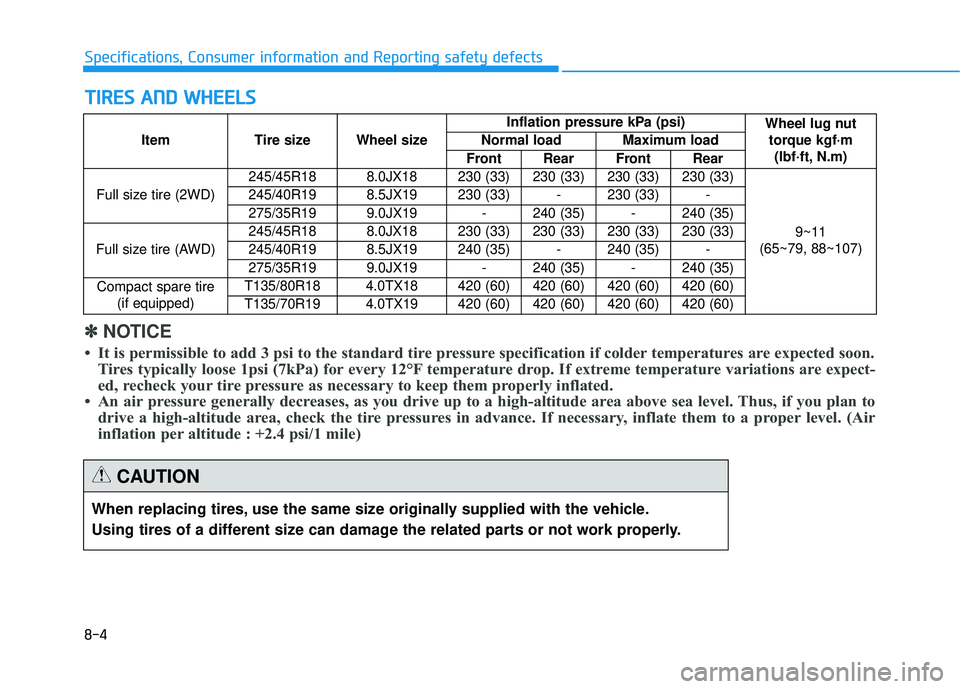GENESIS G80 2017 Owner's Manual
Manufacturer: GENESIS, Model Year: 2017, Model line: G80, Model: GENESIS G80 2017Pages: 496, PDF Size: 12.82 MB
Page 471 of 496

7-94
Maintenance
E
EM
M I
IS
S S
SI
IO
O N
N
C
C O
O N
NT
TR
R O
O L
L
S
S Y
Y S
ST
T E
EM
M
The emission control system of your
vehicle is covered by a written limited
warranty. Please see the warranty
information contained in the Owner’s
Handbook & Warranty Information
booklet in your vehicle.
Your vehicle is equipped with an
emission control system to meet all
applicable emission regulations.
There are three emission control
systems, as follows.
(1) Crankcase emission control sys-
tem
(2) Evaporative emission control sys- tem
(3) Exhaust emission control system
In order to assure the proper function
of the emission control systems, it is
recommended that you have your
vehicle inspected and maintained by
an authorized retailer of Genesis
Branded products in accordance
with the maintenance schedule in
this manual.1. Crankcase emission control system
The positive crankcase ventilation
system is employed to prevent air
pollution caused by blow-by gases
being emitted from the crankcase.
This system supplies fresh filtered air
to the crankcase through the air
intake hose. Inside the crankcase,
the fresh air mixes with blow-by
gases, which then pass through the
PCV valve into the induction system.
2. Evaporative emission con-trol system including
Onboard Refueling Vapor
Recovery (ORVR)
The Evaporative Emission Control
System is designed to prevent fuel
vapors from escaping into the atmos-
phere. The ORVR system is
designed to allow the vapors from
the fuel tank to be loaded into a can-
ister while refueling at the gas sta-
tion, preventing the escape of fuel
vapors into the atmosphere.
For the Inspection and
Maintenance Test (With Electronic
Stability Control (ESC) system)
To prevent the vehicle from
misfiring during dynamome-
ter testing, turn the Electronic
Stability Control (ESC) sys-
tem off by pressing the ESC
switch (ESC OFF light illumi-
nated).
After dynamometer testing is
completed, turn the ESC sys-
tem back on by pressing the
ESC switch again.
CAUTION
Page 472 of 496

7-95
7
Maintenance
Canister
Fuel vapors generated inside the fuel
tank are absorbed and stored in the
onboard canister. When the engine is
running, the fuel vapors absorbed in
the canister are drawn into the surge
tank through the purge control sole-
noid valve.
Purge Control Solenoid Valve(PCSV)
The purge control solenoid valve is
controlled by the Engine Control
Module (ECM); when the engine
coolant temperature is low during
idling, the PCSV closes so that evap-
orated fuel is not taken into the
engine. After the engine warms-up
during ordinary driving, the PCSV
opens to introduce evaporated fuel to
the engine.
3. Exhaust emission control system
The Exhaust Emission Control
System is a highly effective system
which controls exhaust emissions
while maintaining good vehicle per-
formance.
When the engine starts or fails to
start, excessive attempts to restart
the engine may cause damage to the
emission system.
Vehicle modifications
This vehicle should not be modi-
fied. Modification of your vehicle
could affect its performance, safety
or durability and may even violate
governmental safety and emis-
sions regulations.
In addition, damage or performance
problems resulting from any modifi-
cation may not be covered under
warranty.
If you use unauthorized electronic devices, it may cause the vehicle to
operate abnormally, wire damage,
battery discharge and fire. For your
safety, do not use unauthorized
electronic devices.
Engine exhaust (carbon monox-ide) precautions
Carbon monoxide can be present
with other exhaust fumes. If you
smell exhaust fumes of any kind in
your vehicle, drive with all the win-
dows fully open. Have your vehicle
checked and repaired immediately.
Engine exhaust gases contain
carbon monoxide (CO). Though
colorless and odorless, it is
dangerous and could be lethal if
inhaled. Follow the instructions
on this page to avoid CO poi-
soning.
WARNING
Page 473 of 496

7-96
Maintenance Do not operate the engine in con-fined or closed areas (such as
garages) any more than what is
necessary to move the vehicle in or
out of the area.
When the vehicle is stopped in an open area for more than a short
time with the engine running,
adjust the ventilation system (as
needed) to draw outside air into the
vehicle.
Never sit in a parked or stopped vehicle for any extended time with
the engine running.
When the engine stalls or fails to start, excessive attempts to restart
the engine may cause damage to
the emission control system.
Operating precautions for cat-alytic converters (if equipped)
The exhaust system and cat-
alytic converter are very hot
during and immediately after
the engine has been running. To
avoid SERIOUS INJURY or
DEATH:
Do not park, idle, or drive the
vehicle over or near flamma-
ble objects, such as grass,
vegetation, paper, leaves, etc.
A hot exhaust system can
ignite flammable items under
your vehicle.
(Continued)
WARNING CALIFORNIA PROPOSITION 65
WARNING
Engine exhaust and a wide vari-
ety of automobile components
and parts, including compo-
nents found in the interior fur-
nishings in a vehicle, contain or
emit chemicals known to the
State of California to cause can-
cer and birth defects and repro-
ductive harm. In addition, cer-
tain fluids contained in vehicles
and certain products of compo-
nent wear contain or emit chem-
icals known to the State of
California to cause cancer and
birth defects or other reproduc-
tive harm.
WARNING
Page 474 of 496

7-97
7
Maintenance
Your vehicle is equipped with a cat-
alytic converter emission control
device.
To prevent damage to the catalytic
converter and to your vehicle, take
the following precautions:
Use only UNLEADED FUEL
for gasoline engines.
Do not operate the vehicle
when there are signs of
engine malfunction, such as
misfire or a noticeable loss of
performance.
Do not misuse or abuse the
engine. Examples of misuse
are coasting with the engine
off and descending steep
grades in gear with the engine
off.
Do not operate the engine at
high idle speed for extended
periods (5 minutes or more).(Continued)
CAUTION
(Continued)
Keep away from the exhaust
system and catalytic convert-
er or you may get burned.
Also, Do not remove the heat
sink around the exhaust sys-
tem, do not seal the bottom of
the vehicle, and do not coat
the vehicle for corrosion con-
trol. It may present a fire risk
under certain conditions.
(Continued)
Do not modify or tamper with
any part of the engine or
emission control system. All
inspections and adjustments
must be made by an author-
ized retailer of Genesis
Branded products.
Avoid driving with extremely
low fuel level. If you run out of
gasoline, it could cause the
engine to misfire and result in
excessive loading of the cat-
alytic converter.
Page 475 of 496

7-98
Maintenance
C
CA
A L
LI
IF
F O
O R
RN
N I
IA
A
P
P E
ER
R C
CH
H L
LO
O R
RA
A T
TE
E
N
N O
O T
TI
IC
C E
E
Perchlorate Material-special handling may apply, See: www.dtsc.ca.gov/hazardouswaste/perchlorate.
Notice to California Vehicle Dismantlers:
Perchlorate containing materials, such as air bag inflators, seatbelt pretensioners and keyless remote entry batteries,
must be disposed of according to Title 22 California Code of Regulations Section 67384.10 (a).
Page 476 of 496

888
Specifications & Consumer information
8
Specifications, Consumer information and Reporting safety defects
8
Dimensions ..............................................................8-2
Engine ......................................................................8-\
2
Bulb wattage ...........................................................8-3
Tires and wheels ....................................................8-4
Luggage volume .....................................................8-5
Air conditioning system ........................................8-5
Gross vehicle weight .............................................8-5
Recommended lubricants and capacities ...........8-6
Recommended SAE viscosity number .........................8-7
Vehicle identification number (VIN) ....................8-8
Vehicle certification label .....................................8-8
Tire specification and pressure label .................8-9
Engine number .......................................................8-9
Refrigerant label ....................................................8-9
Consumer information .........................................8-10
Reporting safety defects ....................................8-11
Page 477 of 496

D
DI
IM
M E
EN
N S
SI
IO
O N
NS
S
8-2
Specifications, Consumer information and Reporting safety defects
Item in (mm)
Overall length 196.5 (4,990)
Overall width 74.4 (1,890)
Overall height 58.3 (1,480)
Front tread 64.09 (1,628)*
1/ 63.78 (1,620)*2
Rear tread65.31 (1,659)*1/ 64.29 (1,633)*2
Wheelbase 118.5 (3,010)*1: with R18 tire
*2: with R19 tire
E
E N
N G
GI
IN
N E
E
ItemLambda 3.8Tau 5.0
Displacement cu. in (cc)
230.54 (3,778)307.3 (5,038)
Bore x Stroke in. (mm)
3.78x3.42 (96x87)3.78x3.42 (96x87)
Firing order
1-2-3-4-5-61-2-7-8-4-5-6-3
No. of cylinders
6, V-type8, V-type
Page 478 of 496

B
BU
U L
LB
B
W
W A
AT
TT
TA
A G
G E
E
8-3
88
Specifications, Consumer information and Reporting safety defects
Light Bulb WattageBulb type (W)
Front Headlamp
Low
H11 / D1S55 / 35
High HB3 / BI-FCN 60 / -
Turn signal lamp LED / PY28WLED / 28
Position lamp LEDLED
Daytime running lights LEDLED
Fog lamp LEDLED
Side repeater lamps (Outside mirror) LEDLED
Rear High mounted stop light
LEDLED
Rear combination lamp Turn signal light
28/8W NA / LED 28 / LED
Stop and tail lights (Outside) LEDLED
Stop and tail lights (Inside) LEDLED
Back up light W16W / LED16 / LED
License plate lights LEDLED
Interior Luggage lamp
LEDLED
Map lamp LEDLED
Room lamp LEDLED
Vanity mirror lamp LEDLED
Page 479 of 496

8-4
Specifications, Consumer information and Reporting safety defects
T
TI
IR
R E
ES
S
A
A N
N D
D
W
W H
HE
EE
EL
LS
S
When replacing tires, use the same size originally supplied with the vehicle.
Using tires of a different size can damage the related parts or not work properly.
CAUTION
✽ ✽
NOTICE
• It is permissible to add 3 psi to the standard tire pressure specification if colder temperatures are expected soon.
Tires typically loose 1psi (7kPa) for every 12°F temperature drop. If extreme temperature variations are expect-
ed, recheck your tire pressure as necessary to keep them properly inflated.
• An air pressure generally decreases, as you drive up to a high-altitude area above sea level. Thus, if you plan to drive a high-altitude area, check the tire pressures in advance. If necessary, inflate them to a proper level. (Air
inflation per altitude : +2.4 psi/1 mile)
Item Tire size Wheel size Inflation pressure kPa (psi)
Wheel lug nut
torque kgf·m (lbf·ft, N.m)
Normal load Maximum load
Front Rear Front Rear
Full size tire (2WD) 245/45R18 8.0JX18 230 (33) 230 (33) 230 (33) 230 (33)
9~11
(65~79, 88~107)
245/40R19 8.5JX19 230 (33) - 230 (33) -
275/35R19 9.0JX19 - 240 (35) - 240 (35)
Full size tire (AWD) 245/45R18 8.0JX18 230 (33) 230 (33) 230 (33) 230 (33)
245/40R19 8.5JX19 240 (35) - 240 (35) -
275/35R19 9.0JX19 - 240 (35) - 240 (35)
Compact spare tire (if equipped) T135/80R18 4.0TX18 420 (60) 420 (60) 420 (60) 420 (60)
T135/70R19 4.0TX19 420 (60) 420 (60) 420 (60) 420 (60)
Page 480 of 496

L
LU
U G
GG
GA
AG
G E
E
V
V O
O L
LU
U M
M E
E
8-5
88
Specifications, Consumer information and Reporting safety defects
ltem Lambda 3.8 Tau 5.0
SAE 15.3 cu ft (433 l)
A
A
I
IR
R
C
C O
O N
ND
DI
IT
T I
IO
O N
NI
IN
N G
G
S
S Y
Y S
ST
T E
EM
M
ItemWeight of volume Classification
Refrigerant
700±25g R-134a
Compressor lubricant
120±10g PAG (FD46XG)
We recommend that you contact an authorized retailer of Genesis Branded products for more details.
G
GR
RO
O S
SS
S
V
V E
EH
H I
IC
C L
LE
E
W
W E
EI
IG
G H
H T
T
Lambda 3.8 Tau 5.0
2WD AWD 2WD
AW D
5,379 (2,440) 5,511 (2,500) 5,556 (2,520)
-
lbs (kg)